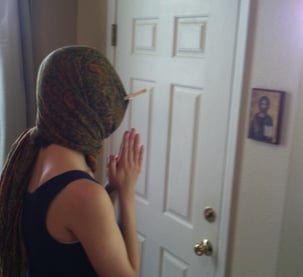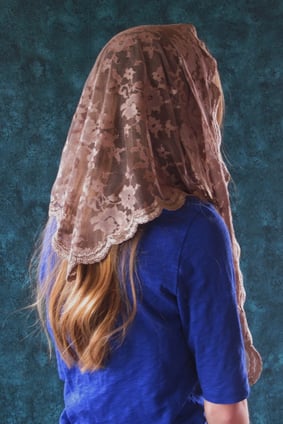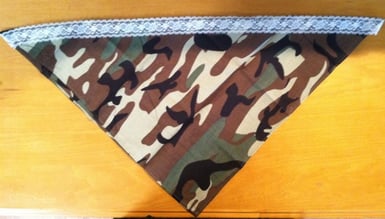Permit me, just this one time, to talk about something that is not uniquely Byzantine but is nonetheless relevant to our tradition:
The chapel veil, or mantilla if you prefer.
 "What's the difference between this Byz-y Mama article and a pencil?" "I don't know, what?" "The pencil has a point!" "AH-hahaha!"
"What's the difference between this Byz-y Mama article and a pencil?" "I don't know, what?" "The pencil has a point!" "AH-hahaha!"
It’s become a hot topic in my local circles and news articles recently. However, many of the discussions surrounding the veil have made the crotchety old man that lives inside my head--he’s kind of like a combined Statler and Waldorf from the Muppets--grumble and shake his cane.
This is mostly because my inner old man grumbles at everything, and this is truly my life’s cross and weakness. But the other reason is that I found a lot of conjecture from the authors about what the veil means and very few people discussing its meaning as given by St. Paul in 1 Corinthians 11 and as interpreted by the Church Fathers and saints.
First, let’s talk about what is being discussed, and with what I’m certain are the best intentions, but why they're not necessarily sufficient reasons:
1) We veil what is sacred. Therefore, woman should be veiled.
I get it. People all over the globe think the Church oppresses women. We want to prove to them that the Church’s theology does nothing of the sort, and so we continually try to point out how sacred woman is in the eyes of the Church. Having many post-modern feminist friends myself, I completely understand that intention.
But men are sacred, too.
So the problem with this logic about the veil is that, when applied consistently, it means that men should also be veiled. While this presents a superb marketing opportunity for the MANtilla in the eyes of my husband, we can’t ignore St. Paul’s exhortation--the one that appears right alongside his discussion on women wearing veils--that men leave their heads uncovered. My husband suggested that the MANtilla could cover his biceps instead, because they are his glory (see #3). Sure, honey.
If the veil is covering what is sacred, it should be worn by everyone, but St. Paul strictly prohibits that. So there must be another reason.
2) Veiling makes prayer/the Mass/the Divine Liturgy special.
I actually completely understand and find a certain validity to the need for something to differentiate between how a person dresses for an elegant dinner and how they are dressing for the holiest of feasts. But why not wear a special necklace or bracelet instead? There is nothing to indicate that a veil should be the accessory of choice.
I've also read and heard some interviews with women expressing their genuine feelings that when they put on the veil, it affected their perception of the Mass or Divine Liturgy; it just made her feel special or more sacred, with no explanation beyond that. However, I think we have to be careful about using merely our perceptions and feelings to justify a spiritual practice. They can be fickle. What happens when they diminish or go away completely, as feelings often do with repetition? What is left to make the veil significant if our main reason for wearing it is how it makes us feel? There must be some other significance--or at least I hope there is some other significance--if the Church called the practice mandatory for so long. I'm not very good at history, but I'm doubtful that the Church has ever enacted a canon law based solely on the idea that it would make people feel good.
3) When a woman puts on a veil, she humbles herself before God.
Possibly, but what is so humbling about it? This could be alluding to the reasons given by St. Paul and the Church Fathers (which I am slowly but surely getting to), but saying only "it is humbling" is too vague.
Some discuss that wearing a veil is humbling because the woman is covering her hair, her "glory" as St. Paul calls it, and they equate this glory to beauty. They say that the woman, in "covering" (the quotes are for those who use lace veils) her hair, acknowledges that God is more beautiful than she is. But doesn't this practically communicate the exact opposite of humility?
"Hey, God, I'm going to cover up my hair today so that you can actually look good by comparison for once, okay?"
Incidentally, this is why I come to church with bed head (no veil) every Sunday; I don't want to show up Jesus on his big day. It has nothing to do with the fact that I keep sleeping in.
4) Veiling blocks out distractions.
Okay, this is the one that makes my inner theological Statler and Waldorf want to just walk out of the theater, even though--as evidenced by that statement--I very much understand the veiler's dilemma. What I am specifically referring to here is women who wear their veil like a hood with the intention of blocking out those around them so they can “focus just on God”. I’ve heard people talk about this helping them to feel like they are having a private meeting with God or like they are hidden from everyone else at Mass. But…
THE POINT OF MASS AND THE DIVINE LITURGY IS TO BE COMMUNAL!
 This is great. I can't see anyone, I can't hear anyone, and most of all, I can't smell anyone...I feel so close to Jesus right now.
This is great. I can't see anyone, I can't hear anyone, and most of all, I can't smell anyone...I feel so close to Jesus right now.
It is absolutely necessary that I somehow experience those around me and that they experience me! That is the point of having a “Church” and not the sort of personal, individual-oriented relationship with God promoted by certain Protestant theologies. In Byzantine theology (though I’m not sure this differs from the Roman), one sees that we can only draw nearer to God if we are also drawing nearer to others.
So for someone to veil themselves with the intention of blocking out those around them in a liturgical setting is unequivocally wrong as far as I can tell. (Although, like I said, I understand! For those of you who, like me, become legitimately distracted and are looking for advice, this article may help).
Okay. So what’s the real reason to wear a veil then? I’ll admit, I had no idea when all these discussions began. I don’t wear a veil myself, and I’d never given it much thought because I seemed to have bigger fish to fry in my spiritual life than what holy accessories to don. But after a more-than-sufficient amount of grumbling about logical holes and inconsistencies in many of the articles going around, I set down my cane and went searching for an answer from the Church Fathers.
The two sources I found to be most helpful were this homily from St. John Chrysostom on 1 Corinthians 11 and this essay from a man compiling information from various Church Fathers and a couple later saints.
They gave no reference to any of the above explanations. Their explanations for a woman wearing a veil can be summarized in two reasons which, now that I’ve read about them, seem like they should have been obvious from the start given St. Paul’s discourse on the subject. (Alas, hindsight is 20/20).
1) It is modest to wear a veil.
It was modesty that prompted St. Paul to ask that woman cover her hair as her "glory", and not some idea that her head uncovered would cause confusion for people about God's Beauty.
However, I think regarding this reason, there is a lot of room for discussion as to whether or not a veil is necessary for modesty in the context of contemporary culture, (and whether or not that means it should only be worn in prayer). Because the Canon Law of both the Byzantine and the Roman churches no longer requires a veil to be worn, I think we can safely say there are contemporary churches and cultures in which the veil is not necessary for modesty.
2) Wearing a veil is a symbol and analogy for woman’s relationship to her husband and thus for the Church’s relationship to Christ. A man is the head of his wife, and Christ is the head of his Church; therefore, a woman covers her head to symbolically demonstrate her submission and the Church’s submission. Likewise, a man should uncover his head to demonstrate his and Christ’s headship. Even though a man, as part of the Body of Christ, is called to submit to Christ, the analogy of the veil is completed by his head remaining uncovered.
 Veils By Lily DID have this explanation for wearing a veil on their website! Plus, her veils are beautiful! (Picure used with permission from Veils By Lily. Image available from http://www.veilsbylily.com/soft-tulle-triangle-mantillas/ )
Veils By Lily DID have this explanation for wearing a veil on their website! Plus, her veils are beautiful! (Picure used with permission from Veils By Lily. Image available from http://www.veilsbylily.com/soft-tulle-triangle-mantillas/ )
First of all, doesn’t this reason make the most sense out of all of them in light of St. Paul’s words?
Moreover, in the proper understanding of submission and of these relationships, is this reason for wearing a veil not incredibly beautiful? Is the deliberateness of these two ways of dressing (veiled for women, uncovered head for men) not fittingly demonstrative of the activeness of each role, especially in a world where submission is seen as something passive? Does it not provide a very relevant reminder to us as women in an age where we are told explicilty and implicitly, by the secular and sometimes even the Catholic culture, that we are somehow better or more sacred than men or that we need to step up and take the lead in our relationships with them? Does it not remind all of us, both men and women, who we are as a Church in relationship to Christ? Does it not continue to unite, rather than divide, the sexes by being intrinsically tied to its male counter-practice and acknowledging our equally sacred and complimentary roles?
Although I was a sworn naked-head, reading St. John Chrysostom’s homily and Donald P. Goodman’s essay makes me want to go out and buy a mantilla right away. Granted, I think there are some other things to consider about wearing a veil at the moment, like my propensity for pride whenever I do something that makes me stand out or what a veil would actually communicate to those around me. But if I did eventually choose to wear a veil, at least it would now be with an understanding as life-giving and relevant as the analogy of man and woman and of Christ and his Bride the Church.
My somewhat difficult question that follows is this: Why weren't people discussing this?
I don’t know. I’m sure there are multiple possibilities: being too busy to search for the best answer, wanting to avoid trying to explain what submission means, having trouble understanding the writings of the Church Fathers and of the saints. Perhaps there were even a few who didn't like the Church Fathers' answers and felt that their own were better. Truthfully, it was a long time into the discussion on chapel veils until I actually went searching for an answer from the Church Fathers. There’s a certain irony to our unwillingness to search for or to discuss the teachings of the Fathers regarding a symbol of submission while we come up with our own conjectures instead.
If there’s one thing I could work on in my marriage and in my spiritual life, it would be my understanding and application of the concept of submission. My husband suggested I write an article on the idea of submission, but I don’t think I really understand it yet. Although understanding the basic meaning of the veil took maybe sixty minutes of Google searching and reading, I feel like understanding submission would take a lot more research and life experience.
One thing that I know for sure is that it is not oppression, nor is it unquestioning obedience. Both of those are acts of slavery, and the Lord has said, "I do not call you slaves, but friends." The Lord has also called everyone to love Him and His people as the first commandments, and true love requires free will. Submission, to be love, requires that we have both the option to say "no" and a sufficient understanding of the actions we undertake in order to love the one who asks them of us. I think we also have to remember that submitting to God and to his law of Love takes precedence over submitting to the laws of men, even our husbands. Beyond this, I am afraid to say more, because I simply don't know yet.
At least for now, when I see someone wearing a veil, or if I decide to wear a veil myself, I’ll be reminded of true, beautiful, active submission, and hopefully those reminders will help me to take time to understand and practice that submission more fully.
Copyright 2014, Brittany Balke
About the Author

Guest
We welcome guest contributors who graciously volunteer their writing for our readers. Please support our guest writers by visiting their sites, purchasing their work, and leaving comments to thank them for sharing their gifts here on CatholicMom.com. To inquire about serving as a guest contributor, contact editor@CatholicMom.com.



.png?width=1806&height=731&name=CatholicMom_hcfm_logo1_pos_871c_2728c%20(002).png)
Comments